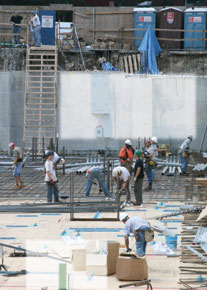 Guy Lawrence / ENR
|
As bad economic news continues to mount it is becoming increasingly clear that last year’s subprime mortgage crisis is spilling over into the overall economy and could eventually threaten still healthy commercial and public construction markets. At the same time, rising energy prices and a weak dollar are giving inflation a new boost.
“Last fall the prospects that the U.S. economy would slide into recession were generally estimated to be about 30%, and that figure has since been revised up to 60% or higher,” says Robert Murray, chief economist for McGraw-Hill Construction, of which ENR is a unit. At the same time, Murray says inflation is making a comeback with the consumer price index climbing 4.2% last November and December, compared to the 2.6% increase for the first 10 months of 2007.
The combination has some economists fearing a return of stagflation, a rare economic phenomenon where weak demand fails to reel in inflation. “I think we can call it stagflation with a small ‘s’,” says Anirban Basu, chief economist for the Associated Builders and Contractors, Washington, D.C. “We see signs everywhere now that nonresidential markets are starting to decelerate. It will begin as weak employment undercuts office buildings and hotels and then spread to public works as states and local governments find they do not have the tax revenue to support aggressive capital spending.”
In response, the Federal Reserve Board “is still committed to cutting interest rates [to stimulate the economy] when inflation pressures are already apparent and this has many people worried,” says Basu. “All things being equal, lower demand would soften prices. But all things are not equal with the price of oil hitting $110 per barrel and the weak dollar pushing up the cost of imports,” he says.
Basu believes that if the stagflation scenario continues to unfold that it will force contractors to take a hard look at labor costs. “I expect that it will be a very intense bargaining season between management and labor,” he says.
Construction inflation started to settle down in 2007, after some wild swings between 2004 and 2006, says Armine Thompson, construction materials economist with Washington, D.C.-based forecasting firm Global Insight. However, she believes that steel, cement and asphalt products could all be set for another round of inflation this summer.
“We were surprised by the 1.9% increase in the producer price index for cement in January,” says Thompson. “Global demand for many construction products remains strong and producers have pricing power. The domestic market is no longer the only driver of prices.”
Two other industry economists also grappled with these issues at a March 12 economic outlook forum at this year’s CONEXPO-CON/AGG equipment show, in Las Vegas.
“The Bush administration’s economic stimulus package will help the economy, but it won’t keep the nation out of recession,” said Edward J. Sullivan, chief economist for the Portland Cement Association, a Skokie, Ill.-based trade group. “The economy is already in a recession and it may not be mild. The question is how deep will the entrenchment go and how long will it last.”
The subprime mortgage crisis, tighter consumer credit requirements and increased risk factors associated with commercial lending have placed the country into a recession since December, Sullivan said. Rising oil prices and inflation also are placing upward pressure on interest rates, he says.
Consumer spending accounts for two out of every three dollars in gross domestic product, so what happens when the housing market goes down, businesses start shedding jobs and the government loses tax revenue? “We are in the midst of cyclical correction that will take three consecutive years,” said Sullivan. “Twenty-five states, including Nevada, face budget shortfalls for 2009 and the numbers will worsen as the year goes by.”
Kenneth D. Simonson, chief economist for the Associated General Contractors of America, Washington, D.C., gave a more upbeat outlook. “I don’t think we’re going into recession, but it’s a close call,” he said.
However, Simonson does see a threat from a resurgent inflation. Diesel fuel’s large price hikes, compared to a year ago, along with the importance of diesel fuel to highway construction makes it likely that highway costs will rise again. Conversely, the housing slump will dampen prices for lumber and gypsum product.
“These cross-cutting trends make it likely that the producer price index for construction inputs will accelerate from the 4.5% rate of increase that prevailed in 2006 and 2007 to a 6% to 8% range by the end of 2008,” said Simonson.
Looking beyond 2008, there are two factors that make it likely that the higher inflation rate will be sustained. First, many construction inputs, such as diesel fuel, steel and copper are in demand worldwide. Second, construction will always be dependent on physical delivery of heavy, bulky materials for which transportation and fuel costs are a major part of the delivered price, Simonson said.
Labor accounts for roughly 50% of a construction project. In 2007, despite the high level of nonresidential activity, contractors were generally able to find enough workers due to a massive redeployment of specialty trade contractors from residential to lighter nonresidential projects, Simonson adds.
“In 2008, I expect labor shortages will worsen for a few crafts, pulling average wage rates higher” he said. “Wage increases in nonresidential construction may rise to the 4.5% to 5.5% range in 2008, despite the slowdown in overall activity, and to 5% to 6% in 2009, when residential work begins to compete again for some specialties.”
 Related Link:
Related Link: 
Post a comment to this article
Report Abusive Comment